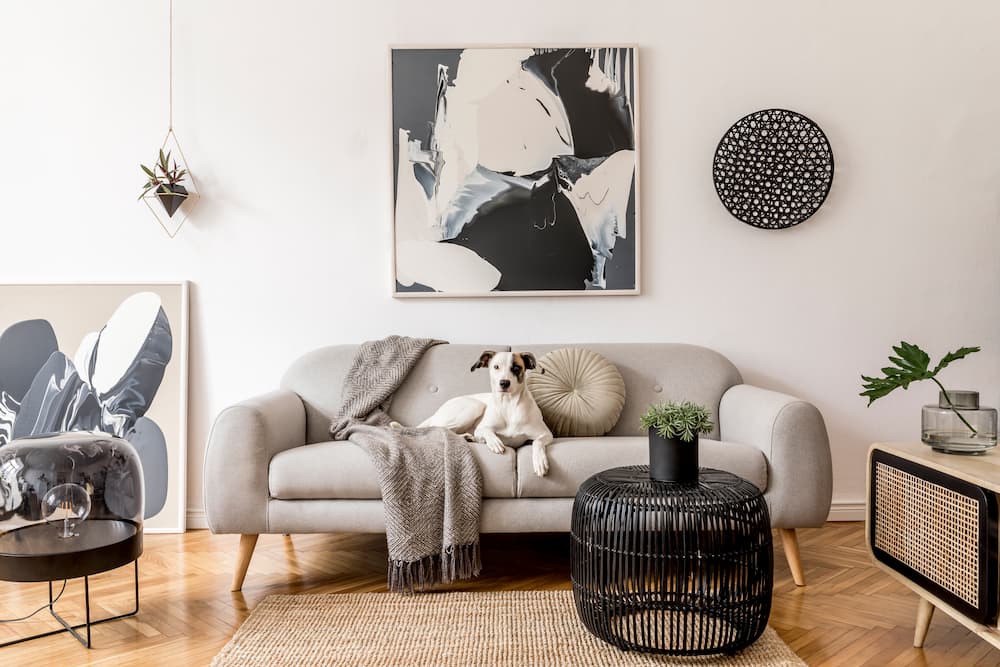How To Learn About Interior Design Basics
Becoming an interior designer usually requires a combination of skill, formal education and training, and a fair amount of raw talent. Crafting a space that balances aesthetics and functionality isn’t necessarily as easy as it looks – and anyone that’s tried to decorate their home can tell you that.
But just because you didn’t attend design school, that doesn’t mean you can’t create a beautiful home that expresses your personal style. From shopping for furniture to choosing window coverings, having a few interior design basics up your sleeve can make the entire process easier (and more enjoyable). With a better understanding of how to decorate a room and some solid knowledge of design principles, as well as help from our experts along the way, you can absolutely turn your house into a stylish home.
For the first-time furniture shopper, design enthusiast, and seasoned stylist alike, we’ve assembled a go-to guide to all things interiors. Covering all the basic things to know about interior design, it’s a useful resource for creating spaces that truly speak to you.
What is Interior Design?
Interior design aims to enhance a given environment, making it aesthetically pleasing, functional, and enjoyable for the people who use it. It’s both an art and a science, and professional interior designers possess a broad range of skills necessary for the job. As an interior designer, you’re typically responsible for all stages of a design project: planning, research, creating a design plan, sourcing furniture and décor, and perfecting the final result.
For most of us, our interest in design isn’t necessarily tied to a dream of working as an interior designer. Instead, many people want to learn more about basic design principles to create more beautiful spaces within their own homes.
Basic Things to Know About Interior Design
While this guide won’t replace years spent in an interior design education program, it can help you make better design decisions for your space. With a working knowledge of the fundamentals of interior design, you have a good foundation for building your own sense of style.
Use these basic principles of interior design as a starting point, but don’t be afraid to infuse your approach with your own personality, creativity, and flair.
Balance
Oftentimes, when a space feels “off,” but you can’t quite put your finger on why, it’s an issue of balance. Balance is the design element that helps create a sense of equilibrium, using shape, color, texture, and even pattern to achieve equal visual weight. It might seem as if you need to be someone with extensive space planning and design experience to achieve balance, but it’s actually something that many people can learn to see and feel intuitively.
You’ll generally see balance categorized into three types:
-
- Symmetrical/formal: Formal spaces, or those that lean traditional, frequently feature symmetrical balance. This means that the space can be visually split into two halves, with each side mirroring the other. For example, a sitting area with two armchairs placed on either side of a coffee table could be described as symmetrically balanced. Symmetrical balance is fairly easy to achieve, but it can also become boring if overused.
- Asymmetrical/informal: Less ordered than symmetrical balance, the asymmetrical balance still balances the visual weights of shapes, lines, colors, and textures. For example, a living room with a large sofa opposite two armchairs would be asymmetrical. In many spaces, this type of balance can provide interesting complexities while also allowing more flexibility.
- Radial: In rooms with a central focal point surrounded by other elements (that are “radiating” around or from it), the balance can be called radial. One common example of radial balance is a round dining table that has several dining chairs spaced around it. The repetition of color, form, and texture contributes to the overall sense of visual balance.
Rhythm
You might think that rhythm is a topic reserved for music, but it’s actually an important part of designing interiors as well. In design, rhythm focuses on creating intention (but often subtle) patterns of contrast and repetition. Not only does it help to move your eye around a space, but it also creates visual interest.
Designers will often incorporate the same shape or color in different places around a single room; for example, carrying a rich emerald green color through a couple of throw pillows, a vintage painting over the fireplace, and as an accent color in a large area rug.
Harmony
When all of the room design elements feel as if they belong together, that is harmony. Harmony is a design principle that establishes the necessity of a sense of unity in a space. You might keep harmony in mind by choosing a neutral, monochromatic color palette for your bedroom, while adding interest with varying textures, shapes, and furniture sizes.
Harmony is the perfect counterpart to rhythm: where rhythm builds visual excitement, harmony acts as a calming presence. Aim to have both in equal measure.
Emphasis
Every room should have at least one element that commands attention, capturing your interest from the moment you enter – in other words, a focal point. Emphasis is the practice of choosing a specific aspect to enhance.
Imagine a luxurious living room with a large fireplace; the fireplace is a built-in point of interest, and you can add emphasis by situating a few cozy chairs around it. Other spaces might incorporate an unusual or large furniture piece, such as a custom sectional, rather than an architectural feature.
Proportion and Scale
Proportion and scale are two halves of a whole, each one necessary to a room’s design. Scale describes how the size of an object (such as a sofa table) is relates to another object or the overall space. Proportion hones in on the specific ratio of the size of one piece to another.
Here’s an example: placing an oversize sectional in a small family room will throw off the scale, because the furniture is out of proportion to the room as a whole. However, an open-concept living room could be the perfect fit for the overstuffed, family-friendly sectional of your dreams.
Discover Your Design Style with Help from the Interior Designer Team at Interior Essentials
Sometimes, the best way to learn how to create stylish spaces is to jump right into the process – and there’s no better place to begin that at Interior Essentials. Our Gilbert and Scottsdale design showrooms are filled with a diverse selection of upscale furnishings, window coverings, décor, and so much more, making it easy to find everything you need to personalize every room in your home.
Still not sure how to find your personal design style? Our award-winning team of experts is here and ready to help. Shopping at other home décor and furniture stores in Phoenix simply can’t compare to the Interior Essentials experience: from our selection to our service, our Valley showrooms are superior in every way. We’re one of the first choices for Phoenix interior designers, and for a good reason. Together, we’ll hone your sense of style, find pieces that align with your design vision, and create spaces that you can’t wait to come home to.
Visit Interior Essentials in Gilbert or Scottsdale today and shop alongside the best interior designers in Arizona.
Featured Image: Followtheflow/Shutterstock

